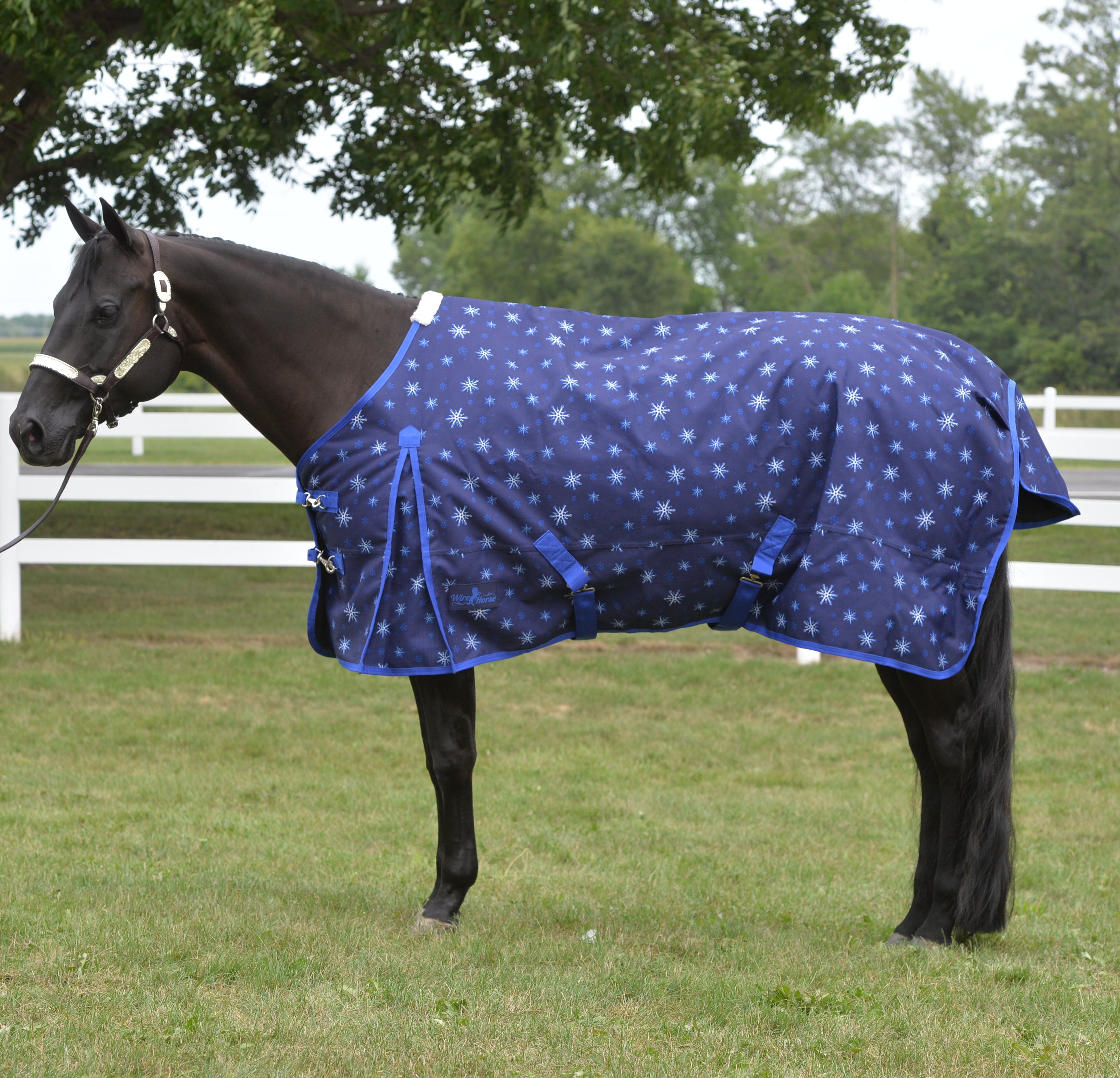
Buying a winter blanket for your horse should not be a stressful chore. Denier? Amount of Fill? Gussets? What size? It can be confusing. Understanding all the different options will help you make sure you are choosing the perfect horse blanket for your horse.
To Blanket or Not To Blanket…That Is the Question
The first decision to make is whether or not to blanket your horse. This is sometimes a matter of preference and sometimes a matter of necessity. Horses will grow an adequate coat to keep them warm in cold temperatures and they will shed those winter coats in the spring and then grow a lighter summer coat. However, blanketing is sometimes necessary, such as show horses that are clipped or have been blanketed so that they did not grow a thick enough coat to protect them from the winter climate. Also, moving a horse from a warmer climate to a colder one may make blanketing necessary. Some people blanket in the early spring to help speed up the shedding out process. And, let’s face it, we have some horses that are just wimpy…they will stand in the rain and shiver when they have a perfectly good lean-to! These equine friends will welcome a horse blanket during the winter months.
Size
The first thing to determine is the blanket size that your horse needs. Horse blankets need to fit correctly: too small and the horse may develop sores where rubbing occurs, too large and they can get easily caught up and tear or cause injury to the horse. Different companies use different sizing measurements, some blankets are sold in odd number measurements and some are sold in even numbers. Adjustments of an inch can easily be made using the buckles or fasteners in the front of the blanket.
If you have an existing horse blanket that fits well but are not sure of the size, you can lay the blanket out flat and measure it from the center front to the back edge. If you are getting the first blanket for the horse you can easily take the measurement. If your tape measure is not long enough, take the measurement using a long piece of twine or string. Place one end of the twine in the center of the horse’s chest. Then run it along the side of the horse to the end point you want the blanket to stop. Make sure the horse is standing quietly on level ground. Also, make sure that the twine is taut (but not pulled extremely tight) and travels in a straight line from front to back. Mark the point at the rear end with a marker. Then use a tape measure to determine the length. If your horse measures 73” and the blanket you want only comes in even measurements, just add 1” to be sure the blanket is not too tight.
Denier
Denier refers to the toughness of the fabric. It has no correlation to the thickness or degree of fill. Higher denier means a tougher outer shell that will be less likely to rip or tear from normal use. 600 denier blankets are at the low end, 800 -1000 are in the medium range of durability, 1200-1680 are the toughest deniers. Ballistic nylon deniers are the toughest of any fabric and are very durable. Depending on how tough your horse and/or its pasture mates are on blankets, you can decide which range of denier is right for your situation.
Fill
The amount of fill will determine the warmth that the blanket will provide. Most horse blankets fall into the following general ranges:
- Sheets: No fill. These are good for protecting from rain and wind.
- Lightweight: 100–150 grams of fill. Offers protection in 35-50 degree F temperatures.
- Mediumweight: 150-250 grams of fill. Offers protection in 20-40 degree F temperatures.
- Heavyweight: 300-400 grams of fill. Offers protection below 25 degree F temperatures.
In addition to the outside temperature your horse is exposed to, there are other factors in play. You should consider whether or not your horse has been body clipped. Without its natural winter blanket, you will need to increase the amount of fill to compensate for the loss of winter coat. Older horses often don’t tolerate cold temperatures as well as younger horses—much like us humans. Also, since temperatures do change, you will need to plan on changing blankets as temperatures fluctuate. If your horse is sweating under its blanket, it’s time to use a blanket with less fill.
Liners
Blanket liners are a great way to add extra warmth to an existing lighter-weight horse blanket. They come in a wide variety of fabrics, from natural fleece or wool to synthetics. The advantage to liners is that they add another layer of warmth without adding extra bulkiness. Horses that don’t tolerate heavyweight blankets may do well with a medium weight blanket and a liner.
Blanket liners usually don’t have as many sizing straps so it is important to get the correct size and have the outer blanket securely fastened. Also, since the liner is always in direct contact with the horse’s coat, you’ll want to select a liner that is machine washable.
Straps and Buckles
Every horse blanket maker has their own system of straps and or buckles to keep the blankets in place. Things to consider when buying a blanket are ease of fastening and how durable the hardware is. Chest buckles alone or paired with Velcro make the chest fastening more secure. Leg straps should be easily fastened, adjustable, and also stay in place to avoid the possibility of coming loose and getting tangled around the horse’s legs. Tail straps add more security. The fit is very important, but the straps when adjusted properly help keep the blanket even more securely in place.
Gussets
Although not all winter blankets have them, gussets at the shoulder of horse blankets allow for more freedom of movement. There are several different types of gussets, but the important thing is that your winter blanket allows your horse to move about without feeling encumbered by its winter wardrobe.
Final Notes
When blanketing your horse, it is vital that you check your horse daily to make sure the blanket is still on securely and does not have any damage that could be dangerous to your horse. Removing the blanket daily for grooming is also important. Besides the benefit of the grooming, you can check for any signs of rubbing that indicated the blanket was not fitting properly. After the season, repair any rips or tears and have the blanket dry cleaned or washed, depending on the manufacturer’s recommendations.
Happy blanketing!
Links:
https://www.richardbealblog.com/guide-to-buying-a-horse-blanket/
http://betterhorsetraining.com/blog/guide-to-buying-a-horse-blanket/
Leave a comment




